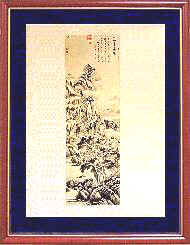
 |
| 18"x24" |
Tung
Ch'i-ch'ang (1555-1636)
Original: Hanging scroll, monochrome ink on paper, 321.9 X 102.3 cm.
 |
 |
 |
 |
Tung
Ch'i-ch'ang, employing only monochrome ink, depicts mountains and
boulders, trees and woods, streams and rivers, and cottages and slopes-all
well placed in a landscape that is here piled into a composition of power
and grandeur. In the upper right corner is the title Hsia-mu ch'ui-yin
(lit. Summer trees casting shades) inscribed by the artist, who further
says:
I
once viewed the painting Hsia-mu ch'ui-yin by Tung Yuan at Wu K'uan's
residence in Chang-an and
I
realized that though Huang Kung-wang surpassed Tung Yuan, he learned his
art from the older master.
Mi
Fei used to comment on his own calligraphy, saying that his tongue could
well express what his brush
could
not follow, such is the case with my painting. (Signed) Tung Hsiian-tsai.
(Two seals) :Tsung-po Hsueh-
shih
(and) Tung Hsuan-tsai Shih.
In this landscape, Tung uses the practices and movements of calligraphic brushstroke and though he employ sink with tremendous variations from the thickest through the most dilute and from the dryest to the moistest, the dominant tone is set by the use of the richly wet brush.
Tung Ch'i-ch'ang was born in 1555, a native of Hua-t’ing, Chiang-su Province. His style name was Hsuan-tsai; his sobriquet Ssu-pai. He obtained the degree of chin-shih in 1588, became a prominent official and ultimately rose to be President of the Board of Rites. He was an outstanding calligrapher and was acclaimed as the best of the Ming dynasty in both semi-cursive and cursive scripts. In landscape painting, he not only acquired a perfect command of the styles of the Sung and Yuan masters but also created his own style, a style that is elegant, refined, and coolly intellectual in mood. His reputation in painting was not below that of the Four Masters of the Ming dynasty – Shen Chou, T'ang Ying, Ch'iu Ying and Wen Cheng-ming. Tung was an avid collector and a distinguished connoisseur. He wrote several books and was considered the foremost authority on painting of his age and of lasting influence. He died in 1636 at the age of 82 sui and was granted the posthumous name Wen-ming.